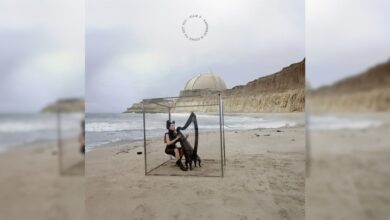Concert Review: Ultraviolet explores new sonic frontiers
 Joshua Storie
Joshua StorieThe evening featured eclectic new works by Albertan composers
What: Farm-to-Table: Fresh Local Music
When: Friday, January 11th at 7:30pm
Where: Convocation Hall
Performers: Ultraviolet (Roger Admiral, Amy Nicholson, Allison Balcetis, Chenoa Anderson)
Composers: Brian Garbet, Emilie LeBel, Alexander Prior, Dorothy Chang, Ian Crutchley, Dave Wall, Erin Rogers
Aptly named, Ultraviolet is a quartet that plays music not usually visible to the mainstream. In that spirit, in Farm-to-Table: Fresh Local Music, Ultraviolet sought to play experimental music on the bleeding edge of what is new in sound.
A particularly harmonious piece was “Rise Up, Singing,” by Erin Rogers. Inspired by the jazz classic “Summertime,” as performed by Ella Fitzgerald and Louis Armstrong, Rogers conveyed a decidedly more somber tone in her composition.
The chords were regularly extended on the cello, a challenge that the cellist, Amy Nicholson, met with extraordinary technique. However, the way the chords were stretched out made it feel much more unnatural, uncomfortable, and dark than Armstrong and Fitzgerald’s original piece.
“Elegy” by Alexander Prior and “Bagatelles” by Dorothy Chang were similar in their use of chords and a refrain to convey a main theme. They also followed more traditional music patterns, especially in Chang’s use of rhythm studies to create her movements. These were outliers, though, from the eclectic offerings of the rest of the concert.
Dave Wall’s “Pebble, Ripple, Stream” was musical onomatopoeia. As he introduced his music, Wall stated that he knew, as most do, what a pebble sounds like as it drops on the ground or into the water, as well as what sounds a stream makes. However, he was less certain in his composition about the sound of a “ripple,” so he endeavored to capture the essence of that phenomenon by writing music conveying a sense of radiating energy.
The “pebble,” as played by the pianist, was a mallet tapped on the wooden inside of the piano, which created an echo within the instrument. This action started a sort of chain reaction: the other instruments would emanate the ripple fading into the noise of the stream, before another “pebble” would start the process all over again.
A similar piece was Emilie LeBel’s “Intaglio,” which mimicked a printmaking process. This piece was more abstract, subtly representing the slow and deliberate movements of printmaking through elongated and dissonant chords. And while the minor key did add a recognizable element to the composition, any pattern seemed to be lacking.
Ian Crutchley composed the most abstract piece of the evening: “…And the Rest of You — If You’ll Just Rattle Your Jewelry.” Before the piece, Crutchley distributed many different noisemakers, from marbles to whistles to dog toys, which the audience used to contribute to the piece. During the performance, the musicians participated in a type of call-and-response while making other sounds, including that of a radio, a tape recording, and a vibrating toothbrush in a metal bowl. The piece was novel, but seemed to be without any particular melody or overarching theme.
However, Brian Garbet’s two pieces fully embraced the New Complexity style of music by using graphic scores, a type of musical notation which seeks to document music in a non-conventional form on paper. Entitled “A Matter of Life” and “Subatomic,” Garbet mentioned how these pieces reflected his view of many large-scale events happening on Earth, most notably climate change.
Highly atonal and busy, these pieces displayed a form of organized chaos. They appeared to be written to display the most disorganization possible. One might compare it to how a construction demolition crew works to organize maximal destruction when knocking down a building. That level of organization and coordination is a piece of art in itself, despite the conflicting chords.
However, what I found most frustrating about many of these pieces was how vague and random they felt. Music benefits from a cyclical pattern that can be followed with anticipation, through the ups and downs, with a surprise here and there through a sudden shift in time or key. Many of the pieces here lacked that recognizable pattern.
Ultraviolet’s repertory is almost entirely too chaotic, with very few distinguishing features to the untrained ear. It’s a very niche category of music, ahead of the mainstream. For those inclined to the more abstract, atonal, and frankly discomforting side of music, these composers are worth checking out. It is interesting to reconsider what music is and can be outside of the traditional sense. However, the listener should be prepared to have nothing familiar to cling onto when listening to this music. After all, we cannot learn anything if we do not first dare to enter the void.




